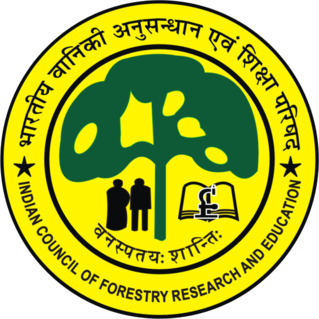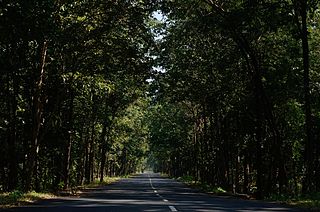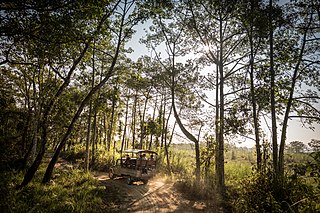
Environmental laws are laws that protect the environment. Environmental law is the collection of laws, regulations, agreements and common law that governs how humans interact with their environment. This includes environmental regulations; laws governing management of natural resources, such as forests, minerals, or fisheries; and related topics such as environmental impact assessments. Environmental law is seen as the body of laws concerned with the protection of living things from the harm that human activity may immediately or eventually cause to them or their species, either directly or to the media and the habits on which they depend.

Forestry laws govern activities in designated forest lands, most commonly with respect to forest management and timber harvesting. Forestry laws generally adopt management policies for public forest resources, such as multiple use and sustained yield. Forest management is split between private and public management, with public forests being sovereign property of the State. Forestry laws are now considered an international affair.

There are four categories of protected areas in India, constituted under the Wildlife Protection Act, 1972. Tiger reserves consist of areas under national parks and wildlife sanctuaries. There are 53 tiger reserves in India. As of January 2023, the protected areas of India cover 173,629.52 square kilometres (67,038.73 sq mi), roughly 5.28% of the total geographical area of the country.
The Forest Legacy Program was established in the 1990 United States farm bill to protect environmentally important forest lands that are threatened by conversion to nonforest uses. It provides federal funding for conservation easements and fee simple purchases.

The Indian Council of Forestry Research and Education (ICFRE) is an autonomous organisation or governmental agency under the MoEFCC, Government of India. Headquartered in Dehradun, its functions are to conduct forestry research; transfer the technologies developed to the states of India and other user agencies; and to impart forestry education. The council has 9 research institutes and 4 advanced centres to cater to the research needs of different bio-geographical regions. These are located at Dehradun, Shimla, Ranchi, Jorhat, Jabalpur, Jodhpur, Bengaluru, Coimbatore, Prayagraj, Chhindwara, Aizawl, Hyderabad and Agartala.

The Indian Forest Act, 1927 was largely based on previous Indian Forest Acts implemented under the British Raj. The most famous one was the Indian Forest Act of 1878. Both the 1878 Act and the 1927 Act sought to consolidate and reserve the areas having forest cover, or significant wildlife, to regulate movement and transit of forest produce, and duty leviable on timber and other forest produce. It also defines the procedure to be followed for declaring an area to be a Reserved Forest, a Protected Forest or a Village Forest. It defines what is a forest offence, what are the acts prohibited inside a Reserved Forest, and penalties leviable on violation of the provisions of the Act.

Joint Forest Management often abbreviated as JFM is the official and popular term in India for partnerships in forest movement involving both the state forest departments and local communities. The policies and objectives of Joint Forest Movement are detailed in the Indian comprehensive National Forest Policy of 1988 and the Joint Forest Management Guidelines of 1990 of the Government of India.

Social forestry is the management and protection of forests and afforestation of barren and deforested lands with the purpose of helping environmental, social and rural development. The term social forestry was first used in 1976 by The National Commission on Agriculture, when the government of India aimed to reduce pressure on forests by planting trees on all unused and fallow lands. It was intended as a democratic approach to forest conservation and usage, maximizing land utilization for multiple purposes.
A reserved forest and protected forest in India is a forest accorded a certain degree of protection. The concept was introduced in the Indian Forest Act of 1927 during the British Raj to refer to forests granted protection under the British crown in British India, but not associated suzerainties. After Indian independence, the Government of India retained the status of the reserved and protected forests, and extended protection to other forests. Many forests that came under the jurisdiction of the Government of India during the political integration of India were initially granted such protection.

Conservation reserves and community reserves in India are terms denoting protected areas of India which typically act as buffer zones to or connectors and migration corridors between established national parks, wildlife sanctuaries and reserved and protected forests of India. Such areas are designated as conservation areas if they are uninhabited and completely owned by the Government of India but used for subsistence by communities, and community areas if part of the lands are privately owned. Administration of such reserves would be through local people and local agencies like the gram panchayat, as in the case of communal forests.

Kāvû is the traditional name given for sacred groves across the Malabar Coast in Kerala, South India. Kavus are notable for Theyyam, the centuries-old ritual dance.

Forestry in India is a significant rural industry and a major environmental resource. India is one of the ten most forest-rich countries of the world. Together, India and 9 other countries account for 67 percent of the total forest area of the world. India's forest cover grew at 0.20% annually over 1990–2000, and has grown at the rate of 0.7% per year over 2000–2010, after decades where forest degradation was a matter of serious concern.
A conservation reserve is a protected area set aside for conservation purposes.

Community forestry is an evolving branch of forestry whereby the local community plays a significant role in forest management and land use decision making by themselves in the facilitating support of government as well as change agents. It involves the participation and collaboration of various stakeholders including community, government and non-governmental organisations (NGOs). The level of involvement of each of these groups is dependent on the specific community forest project, the management system in use and the region. It gained prominence in the mid-1970s and examples of community forestry can now be seen in many countries including Nepal, Indonesia, Korea, Brazil, India, Sri Lanka and North America.

Conservation in India can be traced to the time of Ashoka, tracing to the Ashoka Pillar Edicts as one of the earliest conservation efforts in the world. Conservation generally refers to the act of carefully and efficiently using natural resources. Conservation efforts begun in India before 5 AD, as efforts are made to have a forest administration. The Ministry of Environment, Forest and Climate Change is the ministry responsible for implementation of environmental and forestry program in India, which include the management of national parks, conservation of flora and fauna of India, and pollution controls.
The Communal Areas Management Programme for Indigenous Resources (CAMPFIRE) is a Zimbabwean community-based natural resource management program. It is one of the first programs to consider wildlife as renewable natural resources, while addressing the allocation of its ownership to indigenous peoples in and around conservation protected areas.

The Provisions of the Panchayats Act, 1996 abbreviated as PESA Act is a law enacted by the Government of India for ensuring self governance through traditional Gram Sabhas for people living in the Scheduled Areas of India. Scheduled Areas are areas identified by the Fifth Schedule of the Constitution of India. Scheduled Areas are found in ten states of India which have predominant population of tribal communities. The Scheduled Areas, were not covered by the 73rd Constitutional Amendment or Panchayati Raj Act of the Indian Constitution as provided in the Part IX of the Constitution. PESA was enacted on 24 December 1996 to extend the provisions of Part IX of the Constitution to Scheduled Areas, with certain exceptions and modifications. PESA sought to enable the Panchayats at appropriate levels and Gram Sabhas to implement a system of self-governance with respect to a number of issues such as customary resources, minor forest produce, minor minerals, minor water bodies, selection of beneficiaries, sanction of projects, and control over local institutions. PESA is an Act to provide for the extension of the provisions of Part IX of the Constitution relating to the Panchayats and the Scheduled Areas. PESA was viewed as a positive development for tribal communities in Scheduled Areas who had earlier suffered tremendously from engagement with modern development processes and from the operation of both colonial laws and statutes made in independent India. The loss of access to forest, land, and other community resources had increased their vulnerability. Rampant land acquisition and displacement due to development projects had led to large scale distress in tribal communities living in Scheduled Areas. PESA was seen as a panacea for many of these vulnerabilities and sought to introduce a new paradigm of development where the tribal communities in such Scheduled Areas were to decide by themselves the pace and priorities of their development.

The community forestry program in Nepal is a government effort to reduce forest degradation and to promote sustainable forestry practices as well as to improve the livelihood of the community. It incorporates distinct policies, institutions and practices. The two main goals of the community forestry program is to empower local communities whilst encouraging environmental conservation benefits on the Himalayan forests.

Dr. Ajit Kumar Banerjee was a noted environmentalist and expert in forest management and is known to be the father of the concept of Joint Forest Management, often abbreviated as JFM. Banerjee received global attention for the Arabari project in West Bengal, India where he introduced the JFM concept for the first time in 1972.

The National Forest Policy, 1988 is an Act of the Parliament of India to revise the previously enacted National Forest Policy of 1952. The 1988 National Forest Policy strongly suggested the idea of empowering and involving local communities in the protection and development of forests. A direct outcome of the National Forest Policy, 1988 was the Joint Forest Management Program instituted in 1990 by the Government of India. It was started on a pilot project basis in West Bengal as early as 1971, and again in the late 1980s with considerable success.












